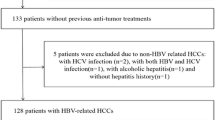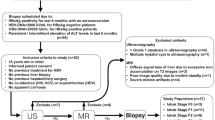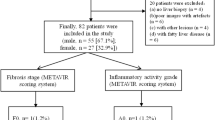Abstract
Purpose
To compare the diagnostic value of apparent diffusion coefficient (ADC) and intravoxel incoherent motion metrics in discriminating histologic grades of hepatocellular carcinoma (HCC) in patients with hepatitis B virus (HBV) infection.
Methods
117 chronic HBV patients with 120 pathologically confirmed HCCs after surgical resection or liver transplantation were enrolled in this retrospective study. Diffusion-weighted imaging was performed using eleven b values (0–1500 s/mm2) and two b values (0, 800 s/mm2) successively on a 3.0 T system. ADC0, 800, ADCtotal, diffusion coefficient (D), pseudodiffusion coefficient (D*), and perfusion fraction (f) were calculated. The parameters of three histologically differentiated subtypes were investigated using Kruskal–Wallis test, Spearman rank correlation, and receiver-operating characteristic analysis. Interobserver agreement was assessed using the intraclass correlation coefficient.
Results
There was excellent agreement for ADCtotal/D/f, good agreement for ADC0,800, and moderate agreement for D*. ADCtotal, ADC0, 800,D, and f were significantly different for well, moderately, and poorly differentiated HCCs (P < 0.001), and they were all inversely correlated with histologic grades: r = − 0.633, − 0.394, − 0.435, and − 0.358, respectively (P < 0.001). ADCtotal demonstrated higher performance than ADC0,800 in diagnosing both well and poorly differentiated HCCs (P < 0.001 and P = 0.04, respectively). ADCtotal showed higher performance than D and f in diagnosing well differentiated HCCs (P < 0.001) and similar performance in diagnosing poorly differentiated HCCs (P = 0.06 and 0.13, respectively).
Conclusions
ADCtotal showed better diagnostic performance than ADC0,800, D, and f to discriminate histologic grades of HCC.


Similar content being viewed by others
References
Torre LA, Bray F, Siegel RL, et al. (2015) Global Cancer Statistics, 2012. CA CANCER J CLIN 65:87-108.
Yang JD, Roberts LR (2010) Epidemiology and Management of Hepatocellular Carcinoma. Infect Dis Clin North Am 24:899-919.
Maluccio M, Covey A (2012) Recent progress in understanding, diagnosing, and treating hepatocellular carcinoma. CA CANCER J CLIN 62:394-399.
Oishi K, Itamoto T, Amano H, et al. (2007) Clinicopathologic features of poorly differentiated hepatocellular carcinoma. J Surg Oncol 95:311-316.
Villanueva A, Hoshida Y, Battiston C, et al. (2011) Combining Clinical, Pathology, and Gene Expression Data to Predict Recurrence of Hepatocellular Carcinoma. GASTROENTEROLOGY 140:1501-1512.
Okusaka T, Okada S, Ueno H, et al. (2002) Satellite lesions in patients with small hepatocellular carcinoma with reference to clinicopathologic features. CANCER-AM CANCER SOC 95:1931-1937.
Robert M, Sofair AN, Thomas A, et al. (2009) A Comparison of Hepatopathologists’ and Community Pathologists’ Review of Liver Biopsy Specimens From Patients With Hepatitis C. CLIN GASTROENTEROL H 7:335-338.
Taouli B, Koh D (2010) Diffusion-weighted MR Imaging of the Liver. RADIOLOGY 254:47-66.
Koh D, Collins DJ (2007) Diffusion-Weighted MRI in the Body: Applications and Challenges in Oncology. AM J Roentgenol 188:1622-1635.
Lewis S, Dyvorne H, Cui Y, et al. (2014) Diffusion-Weighted Imaging of the Liver-Techniques and Applications. MAGN RESON IMAGING C 22:373-395.
Li X, Zhang K, Shi Y, et al. (2016) Correlations between the minimum and mean apparent diffusion coefficient values of hepatocellular carcinoma and tumor grade. J Magn Reson Imaging. 44:1442-1447.
Muhi A, Ichikawa T, Motosugi U, et al. (2009) High-b-value diffusion-weighted MR imaging of hepatocellular lesions: Estimation of grade of malignancy of hepatocellular carcinoma. J Magn Reson Imaging 30:1005-1011.
An C, Park M, Jeon H, et al. (2012) Prediction of the histopathological grade of hepatocellular carcinoma using qualitative diffusion-weighted, dynamic, and hepatobiliary phase MRI. EUR RADIOL 22:1701-1708.
Jiang T, Xu JH, Zou Y, et al. (2017) Diffusion-weighted imaging (DWI) of hepatocellular carcinomas: a retrospective analysis of the correlation between qualitative and quantitative DWI and tumour grade. CLIN RADIOL 72:465-472.
Tang Y, Wang H, Ma L, et al. (2016) Diffusion-weighted imaging of hepatocellular carcinomas: a retrospective analysis of correlation between apparent diffusion coefficients and histological grade. ABDOM RADIOL 41:1539-1545.
Nasu K, Kuroki Y, Tsukamoto T, et al. (2009) Diffusion-Weighted Imaging of Surgically Resected Hepatocellular Carcinoma: Imaging Characteristics and Relationship Among Signal Intensity, Apparent Diffusion Coefficient, and Histopathologic Grade. AM J Roentgenol 193:438-444.
Chang W, Chen R, Chou C, et al. (2014) Histological grade of hepatocellular carcinoma correlates with arterial enhancement on gadoxetic acid-enhanced and diffusion-weighted MR images. ABDOM IMAGING 39:1202-1212.
Saito K, Moriyasu F, Sugimoto K, et al. (2012) Histological grade of differentiation of hepatocellular carcinoma: comparison of the efficacy of diffusion-weighted MRI with T2-weighted imaging and angiography-assisted CT. J Med Imaging Radiat Oncol 56:261-269.
Koh D, Collins DJ, Orton MR (2011) Intravoxel Incoherent Motion in Body Diffusion-Weighted MRI: Reality and Challenges. AM J ROENTGENOL 196:1351-1361.
Le Bihan D, Breton E, Lallemand D, et al. (1988) Separation of diffusion and perfusion in intravoxel incoherent motion MR imaging. RADIOLOGY 168:497-505.
Woo S, Lee JM, Yoon JH, et al. (2014) Intravoxel incoherent motion diffusion-weighted MR imaging of hepatocellular carcinoma: correlation with enhancement degree and histologic grade. RADIOLOGY 270:758-767.
Granata V, Fusco R, Catalano O, et al. (2016) Intravoxel incoherent motion (IVIM) in diffusion-weighted imaging (DWI) for Hepatocellular carcinoma: correlation with histologic grade. Oncotarget 7:79357–79364.
Shan Q, Chen J, Zhang T, et al. (2017) Evaluating histologic differentiation of hepatitis B virus-related hepatocellular carcinoma using intravoxel incoherent motion and AFP levels alone and in combination. ABDOM RADIOL 42:2079-2088.
Zhang Y, Kuang S, Shan Q, et al. (2019) Can IVIM help predict HCC recurrence after hepatectomy? EUR RADIOL.https://doi.org/10.1007/s00330-019-06180-1. [Epub ahead of print].
Wurnig MC, Donati OF, Ulbrich E, et al. (2015) Systematic analysis of the intravoxel incoherent motion threshold separating perfusion and diffusion effects: Proposal of a standardized algorithm. MAGN RESON MED 74:1414-1422.
Kim SY, Lee SS, Byun JH, et al. (2010) Malignant Hepatic Tumors: Short- term Reproducibility of Apparent Diffusion Coeffi cients with Breath-hold and Respiratory-triggered Diffusion- weighted MR Imaging. RADIOLOGY 255:815-823.
(1995) Terminology of nodular hepatocellular lesions. International Working Group. HEPATOLOGY 22:983-993.
DeLong E, DeLong D, Clarke-Pearson D (1988) Comparing the Areas Under Two or More Correlated Receiver Operating Characteristic Curves: A Nonparametric Approach. BIOMETRICS 44:837-845.
de Martel C, Maucort-Boulch D, Plummer M, et al. (2015) World-wide relative contribution of hepatitis B and C viruses in hepatocellular carcinoma. HEPATOLOGY 62:1190-1200.
Kao W, Su C, Chau G, et al. (2011) A Comparison of Prognosis between Patients with Hepatitis B and C Virus-related Hepatocellular Carcinoma Undergoing Resection Surgery. WORLD J SURG 35:858-867.
Zhou Y, Si X, Wu L, et al. (2011) Influence of viral hepatitis status on prognosis in patients undergoing hepatic resection for hepatocellular carcinoma: a meta-analysis of observational studies. WORLD J SURG ONCOL 9:108.
Lewin M, Fartoux L, Vignaud A, et al. (2011) The diffusion-weighted imaging perfusion fraction f is a potential marker of sorafenib treatment in advanced hepatocellular carcinoma: a pilot study. EUR RADIOL 21:281-290.
Kakite S, Dyvorne H, Besa C, et al. (2015) Hepatocellular carcinoma: short-term reproducibility of apparent diffusion coefficient and intravoxel incoherent motion parameters at 3.0T. J MAGN RESON IMAGING 41:149-156.
Watanabe H, Kanematsu M, Goshima S, et al. (2013) Characterizing focal hepatic lesions by free-breathing intravoxel incoherent motion MRI at 3.0 T. ACTA RADIOL 55:1166-1173.
Doblas S, Wagner M, Leitao HS, et al. (2013) Determination of malignancy and characterization of hepatic tumor type with diffusion-weighted magnetic resonance imaging: comparison of apparent diffusion coefficient and intravoxel incoherent motion-derived measurements. INVEST RADIOL 48:722-728.
Colagrande S, Regini F, Pasquinelli F, et al. (2013) Focal liver lesion classification and characterization in noncirrhotic liver: a prospective comparison of diffusion-weighted magnetic resonance-related parameters. J Comput Assist Tomogr 37:560-567.
Zhu L, Cheng Q, Luo W, et al. (2015) A comparative study of apparent diffusion coefficient and intravoxel incoherent motion-derived parameters for the characterization of common solid hepatic tumors. ACTA RADIOL 56:1411-1418.
Luo M, Zhang L, Jiang XH, et al. (2017) Intravoxel incoherent motion: application in differentiation of hepatocellular carcinoma and focal nodular hyperplasia. DIAGN INTERV RADIOL 23:263-271.
Yoon JH, Lee JM, Yu MH, et al. (2014) Evaluation of hepatic focal lesions using diffusion-weighted MR imaging: Comparison of apparent diffusion coefficient and intravoxel incoherent motion-derived parameters. J MAGN RESON IMAGING 39:276-285.
Goshima S, Kanematsu M, Kondo H, et al. (2008) Diffusion-weighted imaging of the liver: Optimizing b value for the detection and characterization of benign and malignant hepatic lesions. J MAGN RESON IMAGING 28:691-697.
Kim SY, Lee SS, Park B, et al. (2012) Reproducibility of Measurement of Apparent Diffusion Coefficients of Malignant Hepatic Tumors: Effect of DWI Techniques and Calculation Methods. J MAGN RESON IMAGING 36:1131-1138.
Kaya B, Koc Z (2014) Diffusion-weighted MRI and optimal b-value for characterization of liver lesions. ACTA RADIOL 55:532-542.
Tang L, Zhou XJ (2019) Diffusion MRI of cancer: From low to high b-values. J MAGN RESON IMAGING 49:23-40.
Wei Y, Gao F, Wang M, et al. (2019) Intravoxel incoherent motion diffusion-weighted imaging for assessment of histologic grade of hepatocellular carcinoma: comparison of three methods for positioning region of interest. EUR RADIOL 29:535-544.
Lemke A, Laun FB, Klauss M, et al. (2009) Differentiation of pancreas carcinoma from healthy pancreatic tissue using multiple b-values: comparison of apparent diffusion coefficient and intravoxel incoherent motion derived parameters. INVEST RADIOL 44:769-775.
ter Voert EEGW, Delso G, Porto M, et al. (2016) Intravoxel Incoherent Motion Protocol Evaluation and Data Quality in Normal and Malignant Liver Tissue and Comparison to the Literature. INVEST RADIOL 51:90-99.
Ni P, Lin Y, Zhong Q, et al. (2016) Technical advancements and protocol optimization of diffusion-weighted imaging (DWI) in liver. ABDOM RADIOL 41:189-202.
Wagner M, Doblas S, Daire J, et al. (2012) Diffusion-weighted MR Imaging for the Regional Characterization of Liver Tumors. RADIOLOGY 264:464-472.
Xu Y, Liu H, Xi D, et al. (2019) Whole-lesion histogram analysis metrics of the apparent diffusion coefficient: a correlation study with histological grade of hepatocellular carcinoma. ABDOM RADIOL 44:3089-3098.
Han X, Suo S, Sun Y, et al. (2017) Apparent diffusion coefficient measurement in glioma: Influence of region-of-interest determination methods on apparent diffusion coefficient values, interobserver variability, time efficiency, and diagnostic ability. J MAGN RESON IMAGING 45:722-730.
Lee Y, Lee SS, Kim N, et al. (2015) Intravoxel incoherent motion diffusion-weighted MR imaging of the liver: effect of triggering methods on regional variability and measurement repeatability of quantitative parameters. RADIOLOGY 274:405-415.
Iima M, Le Bihan D (2016) Clinical Intravoxel Incoherent Motion and Diffusion MR Imaging: Past, Present, and Future. RADIOLOGY 278:13-32.
Funding
The scientific guarantor of this publication is Jin Wang. The authors of this manuscript declare no relationships with any companies, products or services of which may be related to the subject matter of the article. This study has received funding from Science and Technology Program of Guangzhou, China (No. 201704020016) and the National Natural Science Foundation of China (81271562).
Author information
Authors and Affiliations
Corresponding author
Ethics declarations
Conflict of interest
The authors declare that they have no conflicts of interest.
Ethical approval
All procedures performed in studies involving human participants were in accordance with the ethical standards of the institutional and/or national research committee and with the 1964 Helsinki declaration and its later amendments or comparable ethical standards. For this type of study formal consent is not required.
Informed consent
The Institutional review board approved the study, and this study did not require additional informed consent for reviewing the patients’ medical records and image.
Additional information
Publisher's Note
Springer Nature remains neutral with regard to jurisdictional claims in published maps and institutional affiliations.
Electronic supplementary material
Below is the link to the electronic supplementary material.
Rights and permissions
About this article
Cite this article
Shan, Q., Kuang, S., Zhang, Y. et al. A comparative study of monoexponential versus biexponential models of diffusion-weighted imaging in differentiating histologic grades of hepatitis B virus-related hepatocellular carcinoma. Abdom Radiol 45, 90–100 (2020). https://doi.org/10.1007/s00261-019-02253-3
Published:
Issue Date:
DOI: https://doi.org/10.1007/s00261-019-02253-3




